| Patent Prosecution Highway |
Referenced Items (176, 177, 178, 179, 180, 181, 182, 183, 184, 185, 186, 187, 188, 189, 190, 191, 192, 193, 194, 195, 196, 197, 198, 199, 200, 201, 202, 203, 204, 205, 206, 207, 208, 209, 210, 211, 212, 213, 214, 215, 216, 217, 218, 219, 220, 221, 222, 223, 224, 225, 226, 227, 228, 229, 230, 231, 232, 233, 234, 235, 236, 237, 238, 239, 240, 241, 242, 243, 244, 245, 246) |
(234) Patent Prosecution Highway Pilot Program
between the United States Patent and Trademark Office
and the Intellectual Property Office of Singapore
I. Background
The United States Patent and Trademark Office (USPTO) has established a
21st Century Strategic Plan to transform the USPTO into a more
quality-focused, highly productive, responsive organization supporting a
market-driven intellectual property system. One of the specific action
items of the 21st Century Strategic Plan is to share search results with
other intellectual property offices. By relying on the search results
obtained via partnerships with other intellectual property offices, the
USPTO can reduce duplication of efforts and decrease workload.
From July 2006 to January 2008, the USPTO partnered with the Japan
Patent Office (JPO) to establish the first Patent Prosecution Highway (PPH)
pilot program. The PPH leverages accelerated examination procedures
already available in both offices to allow applicants in both offices to
obtain corresponding patents faster and more efficiently. The PPH also
permits each office to benefit from the work previously done by the other
office, in turn helping to reduce workload and improve patent quality. The
USPTO and the JPO began full implementation of the PPH program starting
January 4, 2008.
USPTO has also commenced separate PPH pilot programs with the United
Kingdom Intellectual Property Office (UK IPO), the Canadian Intellectual
Property Office (CIPO), the Korean Intellectual Property Office (KIPO), IP
Australia (IPAU), the European Patent Office (EPO), and the Danish Patent
and Trademark Office (DKPTO) based on the same or similar framework as the
PPH between the USPTO and JPO.
Following on these partnerships, the USPTO and the Intellectual Property
Office of Singapore (IPOS) have agreed to launch a PPH pilot program
similar to the PPH pilot programs noted above.
II. Patent Prosecution Highway Pilot Program
The PPH was established to enable an applicant whose claims are
determined to be allowable/patentable in the Office of first filing (OFF)
to have the corresponding application filed in the Office of second filing
(OSF) advanced out of turn for examination while at the same time allowing
the OSF to exploit the search and examination results of the OFF.
Where the USPTO is the OFF and the U.S. application contains claims that
are determined to be allowable/patentable, the applicant may request
accelerated examination at IPOS for the corresponding application filed
with IPOS as the OSF. The procedures and requirements for filing a request
with IPOS for participation in the PPH pilot program will be available on
February 2, 2009, from the IPOS Web site at: http://www.ipos.gov.sg/topNav/
hom/. Where IPOS is the OSF, applicant may provide IPOS with the necessary
documents for requesting participation in the PPH pilot program, or request
that IPOS obtain the necessary documents for requesting participation in
the PPH pilot program from the USPTO Public PAIR system. In those rare
situations where the U.S. application has not been published, and therefore
the U.S. file wrapper is not available via Public PAIR, applicant will be
responsible for providing the necessary documents to IPOS.
Where the USPTO is the OSF and the corresponding application filed with
the IPOS as the OFF contains claims that are determined by the IPOS to be
allowable/patentable in a substantive examination carried out in the name
of the IPOS (and not based on examination results adopted by the IPOS from
another office), the applicant may request participation in the PPH pilot
program in the USPTO and petition to make the U.S. application special
under the PPH pilot program. Note that the procedures for a petition to
 Top of Notices (234) December 25, 2012 Top of Notices (234) December 25, 2012 |
US PATENT AND TRADEMARK OFFICE |
1385 CNOG 1018 |
make special under the accelerated examination program set forth in MPEP
708.02(a) do NOT apply to a petition to make special under the PPH pilot
program. The procedures and requirements for filing a request in the USPTO
for participation in the PPH pilot program are set forth below.
A. Trial Period for the PPH Pilot Program
The PPH pilot program will commence on February 2, 2009, for a period of
one year ending on February 2, 2010. The trial period may be extended for
up to an additional year if necessary to adequately assess the feasibility
of the PPH program. The USPTO and IPOS will evaluate the results of the
pilot program to determine whether and how the program should be fully
implemented after the trial period. The Offices may also terminate the PPH
pilot program early if the volume of participation exceeds manageable
level, or for any other reason. Notice will be published if the PPH pilot
program will be terminated before the February 2, 2010 date.
B. Requirements for Requesting Participation in the PPH Pilot Program in
the USPTO
In order to be eligible to participate in the PPH pilot program, the
following conditions must be met:
(1) The U.S. application is
(a) a Paris Convention application which either
(i) validly claims priority under 35 U.S.C. 119(a) and 37 CFR 1.55
to one or more applications filed with IPOS, or
(ii) validly claims priority under 35 U.S.C. 119(a)/365(a) to a PCT
application that contains no priority claims,
or
(b) a national stage application under the PCT (an application which
entered the national stage in the U.S. from a PCT international
application after compliance with 35 U.S.C. 371), which PCT
application
(i) validly claims priority under 35 U.S.C. 365(b) to an
application filed with IPOS, or
(ii) validly claims priority under 35 U.S.C. 365(b) to a PCT
application that contains no priority claims, or
(iii) contains no priority claim,
or
(c) a so-called bypass application filed under 35 U.S.C. 111(a) which
validly claims benefit under 35 U.S.C. 120 to a PCT application,
which PCT application
(i) validly claims priority under 35 U.S.C. 365(b) to an
application filed with IPOS, or
(ii) validly claims priority under 35 U.S.C. 365(b) to a PCT
application that contains no priority claims, or
(iii) contains no priority claim.
Examples of U.S. applications that fall under requirement (1) are:
(1)(a)(i):
- US application with single Paris Convention priority claim to a Singapore
(SG) application
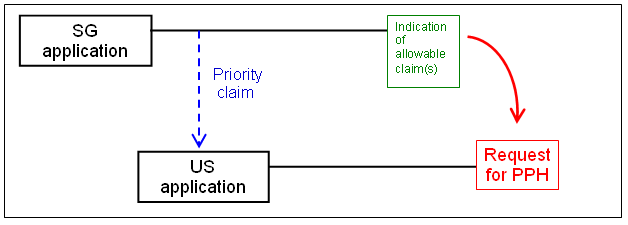
- US application with multiple Paris Convention priority claims to SG
applications
 Top of Notices (234) December 25, 2012 Top of Notices (234) December 25, 2012 |
US PATENT AND TRADEMARK OFFICE |
1385 CNOG 1019 |
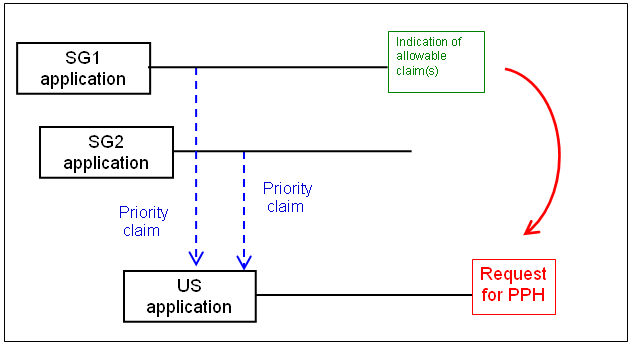
- Paris route and domestic priority
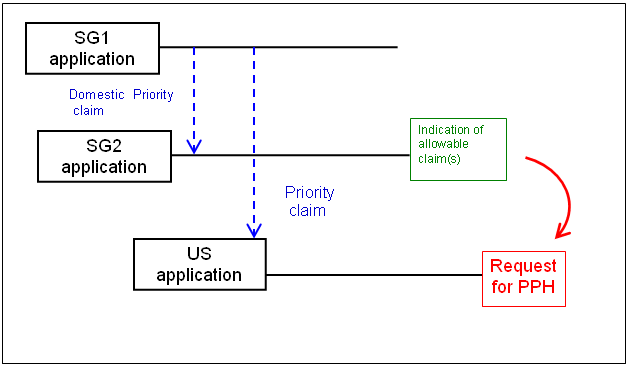
- Paris route and divisional application
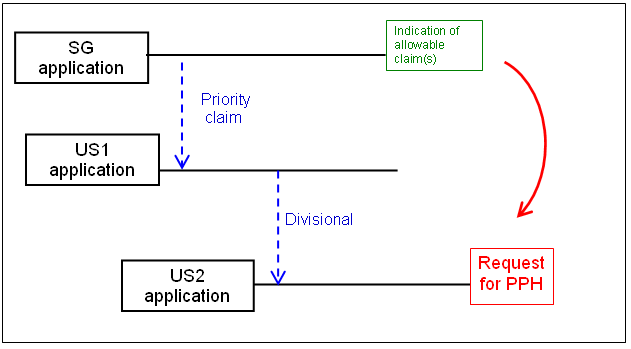
(1)(a)(ii):
- US application claims Paris Convention priority to a PCT application
* DO - Designated Office

(1)(b)(i):
- US application is a national stage of a PCT application which claims
Paris Convention priority to an SG application
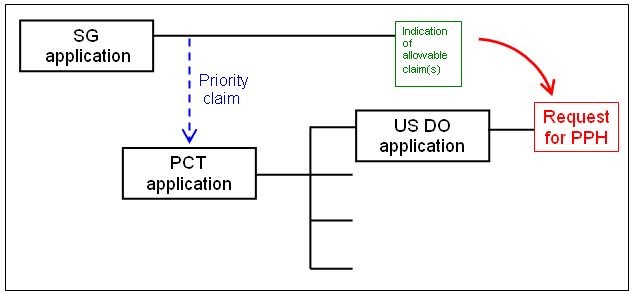
- PCT Route
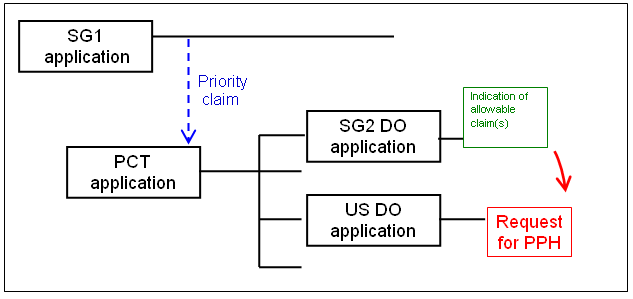
(1)(b)(ii):
- US application is a national stage of a PCT application which claims
Paris Convention priority to another PCT application
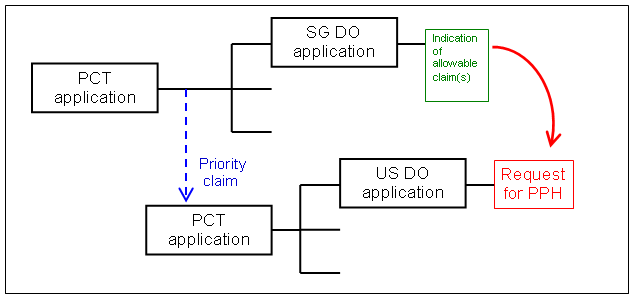
- Direct PCT and PCT Route
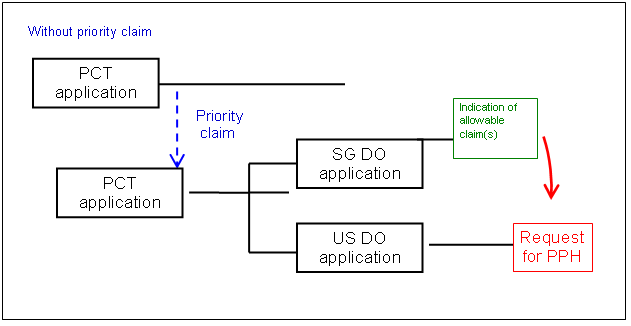
(1)(b)(iii):
- US application is a national stage of a PCT application without priority
claim
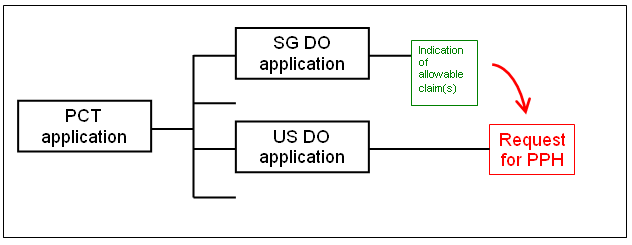
(1)(c)(i):
- US application is a 111(a) bypass of a PCT application which claims Paris
Convention priority to an SG application
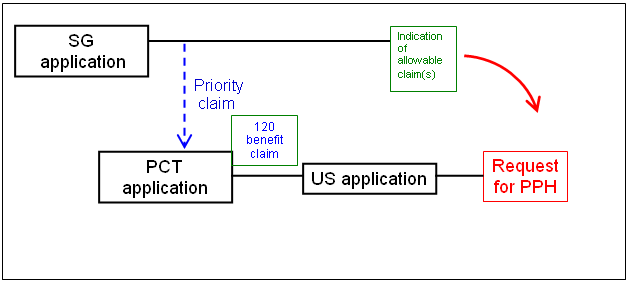
(1)(c)(ii):
- US application is a 111(a) bypass of a PCT application which claims Paris
Convention priority to another PCT application
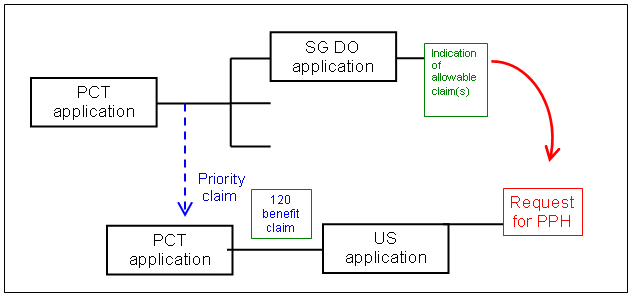
(1)(c)(iii):
- US application is a 111(a) bypass of a PCT application which contains no
priority claim
 Top of Notices (234) December 25, 2012 Top of Notices (234) December 25, 2012 |
US PATENT AND TRADEMARK OFFICE |
1385 CNOG 1020 |
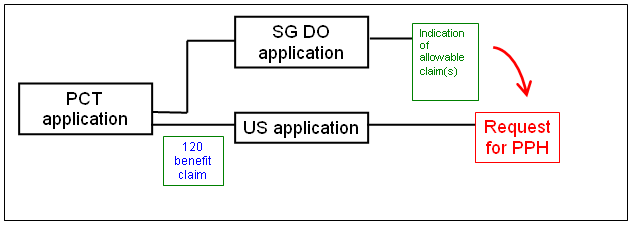
The SG application whose claims are determined to be allowable/patentable
does not have to be the application for which priority is claimed in the
U.S. application (the basic application). The SG application can be an
application explicitly derived from the basic application, e.g., a
divisional application of the basic application. Note that where the SG
application that contains the allowable/patentable claims is not the same
application for which priority is claimed in the U.S. application, applicant
must identify the relationship between the SG application that contains the
allowable/patentable claims and the SG priority application claimed in the
U.S. application (e.g., SG application X that contains the
allowable/patentable claims is a divisional application of SG application
Y, which is the priority application claimed in the U.S. application).
Provisional applications, plant and design applications, reissue
applications, reexamination proceedings, and applications subject to a
secrecy order are excluded and not subject to participation in the PPH.
(2) The SG application(s) have at least one claim that was determined by
the IPOS to be allowable/patentable in a substantive examination carried
out in the name of the IPOS (and not based on examination results
adopted by the IPOS from another office). Applicant must submit a copy of
the allowable/patentable claims from the SG application(s) along with an
English translation thereof and a statement that the English translation
is accurate if the claims are not in the English language. If the SG office
action does not explicitly state that a particular claim is
allowable/patentable, applicant must include a statement in the request for
participation in the PPH pilot program or in the transmittal letter
accompanying the request for participation that no rejection has been made
in the SG office action regarding that claim, and therefore, the claim is
deemed allowable/patentable by IPOS.
(3) All the claims in each U.S. application for which a request for
participation in the PPH pilot program is made must sufficiently correspond
or be amended to sufficiently correspond to the allowable/patentable claims
in the SG application(s). Claims will be considered to sufficiently
correspond where, accounting for differences due to translations and claim
format requirements, the claims are of the same or similar scope. Applicant
is also required to submit a claims correspondence table in English. The
claims correspondence table must indicate how all the claims in the U.S.
application correspond to the allowable/patentable claims in the SG
application(s).
(4) Examination of the U.S. application for which participation in the PPH
pilot program is requested has not begun.
(5) Applicant must file a request for participation in the PPH pilot
program and a petition to make the U.S. application special under the PPH
pilot program. A sample request/petition form (PTO/SB/20SG) will be
available from the USPTO Web site at http://www.uspto.gov on February 2,
2009. Applicants are encouraged to use the USPTO request/petition form. A
petition fee under 37 CFR 1.17(h) for the petition to make special under 37
CFR 1.102(d) is required and must be submitted.
(6) Applicant must submit a copy of all the office actions (which are
relevant to patentability) from each of the SG application(s) containing
the allowable/patentable claims that are the basis for the request, along
with an English translation thereof and a statement that the English
translation is accurate if the office actions are not in the English
language. In addition, applicant must submit copies of any office actions
(which are relevant to patentability) from the SG application(s) issued
after the grant of the request for participation in the PPH pilot program
in the USPTO (especially where IPOS might have reversed a prior holding of
allowability).
 Top of Notices (234) December 25, 2012 Top of Notices (234) December 25, 2012 |
US PATENT AND TRADEMARK OFFICE |
1385 CNOG 1021 |
(7) Applicant must submit an information disclosure statement (IDS) listing
the documents cited by the SG examiner in the SG office action (unless such
an IDS has already been filed in the U.S. application). Applicant must
submit copies of all the documents cited in the SG office action (unless
the copies have already been filed in the U.S. application) except U.S.
patents or U.S. patent application publications.
The request for participation in the PPH pilot program and all the
supporting documents must be submitted to the USPTO via EFS-Web and indexed
with the following document description: "Petition to make special under
Patent Pros Hwy." Information regarding EFS-Web is available at
http://www.uspto.gov/ebc/efs_help.html. Any preliminary amendments and IDS
submitted with the PPH documents must be separately indexed as a
preliminary amendment and IDS, respectively.
Where the request for participation in the PPH pilot program and special
status are granted, applicant will be notified and the U.S. application
will be advanced out of turn for examination. In those instances where the
request for participation in the PPH pilot program does not meet all the
requirements set forth above, applicant will be notified and the defects in
the request will be identified. Applicant will be given one opportunity to
perfect the request in a renewed request for participation (which must be
submitted via EFS-Web and indexed accordingly as noted above). Note that
action on the application by the examiner will NOT be suspended (37 CFR
1.103) awaiting a reply by the applicant to perfect the request in a
renewed request for participation. That is, if the application is picked
up for examination by the examiner after applicant has been notified of the
defects in the request, any renewed request will be dismissed. If the
renewed request is perfected and examination has not begun, the request and
special status will be granted, applicant will be notified and the U.S.
application will be advanced out of turn for examination. If not
perfected, applicant will be notified and the application will await action
in its regular turn.
(8) Request for participation in the PPH pilot program and special status
granted in a parent application will not carry over to a continuing
application. Applicant must fulfill all the conditions set forth above in
order for special status to be granted in the continuing application.
If any of the documents identified in items (2), (6) and (7) above have
already been filed in the U.S. application prior to the request for
participation in the PPH pilot program, it will not be necessary for
applicant to resubmit these documents with the request for participation.
Applicant may simply refer to these documents and indicate in the request
for participation in the PPH pilot program when these documents were
previously filed in the U.S. application.
C. Special Examining Procedures
Once the request for participation in the PPH pilot program and special
status have been granted to the U.S. application, the U.S. application will
be taken up for examination by the U.S. examiner before all other
categories of applications except those clearly in condition for allowance,
those with set time limits, such as examiner's answers, and those that have
been granted special status for "accelerated examination."
Any claims amended or added after the grant of the request for
participation in the PPH pilot program must sufficiently correspond to one
or more allowable/patentable claims in the SG application(s). Applicant is
required to submit a claims correspondence table along with the amendment
(see B.(3) above). If the amended or newly added claims do not
sufficiently correspond to the allowable/patentable claims in the SG
application(s), the amendment will not be entered and will be treated as a
non-responsive reply.
The PPH program does not absolve applicants of all their duties under 37
 Top of Notices (234) December 25, 2012 Top of Notices (234) December 25, 2012 |
US PATENT AND TRADEMARK OFFICE |
1385 CNOG 1022 |
CFR 1.56 and 37 CFR 11.18. By complying with requirements B.(6) and (7)
identified above, applicants would be considered to have complied with
their duties to bring to the attention of the USPTO any material prior art
cited in the corresponding foreign application(s) (see MPEP § 2001.06(a)).
Applicants still have a duty of candor and good faith, including providing
to the USPTO other information known to them to be material to
patentability.
Any inquiries concerning this notice may be directed to Magdalen
Greenlief, Office of the Deputy Commissioner for Patent Examination Policy,
at 571-272-8800 or at magdalen.greenlief@uspto.gov.
January 29, 2009 JOHN J. DOLL
Acting Under Secretary of Commerce
for Intellectual Property and Acting
Director of the United States
Patent and Trademark Office
[1339 OG 160]












